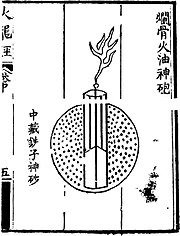Fragmentation (weaponry)


Fragmentation is the process by which the casing,
The correct
These casing pieces are often incorrectly referred to as "shrapnel", particularly by non-military media sources.[1][2][3]
History

The use of fragmentation in bombs dates to the 14th century, and appears in the
For this bomb you take tung oil, yin hsiu, salammoniac, chin chih, scallion juice, and heat them so as to coat a lot of iron pellets and bits of broken porcelain. Then fill in (with a gunpowder core) to a case of cast iron making a fragmentation bomb. When it bursts, it breaks into pieces that wound the skin and break the bones (of enemy soldiers) and blinds their eyes.
— Huolongjing, Part 1 Chapter 2[4]
The modern fragmentation
Difference between fragmentation and shrapnel shells

shrapnel shell
The term "shrapnel" is commonly, although incorrectly from a technical standpoint, used to refer to fragments produced by any explosive weapon. However, the
A shrapnel shell consists of a shell casing filled with steel or lead balls suspended in a
In contrast, a high-explosive shell contains a relatively large and energetic secondary charge of high explosive (known as a burster charge) which, when ignited by the fuse, produces a powerful supersonic
One easy comparison between fragmenting HE and shrapnel shells would be to imagine a shell of each type standing stationary and base-first on the ground; a high-explosive shell would be equally lethal if detonated in this state vs. detonating on impact after being fired, whereas a shrapnel shell would ineffectually fire its contents only a few feet into the air in a cone-shaped pattern (while the casing itself remained intact).[2] However, the reduced area of effect of shrapnel shells can be exploited, such as in the creeping barrage tactics of World War I, where shrapnel shells were able to be used much closer to friendly infantry than HE shells could.
Gallery of images
-
Early artillery shell, with the fragments it would generate. 1900
-
Artillery shell fragment from the Gulf War
-
Grenade fragments in the soft tissue of the lower leg (along with an old fracture of the fibula)
References
- ^ a b Fawcett, Kirstin (20 February 2020). "The Difference Between 'Shell Fragments' and 'Shrapnel'". HistoryNet. Retrieved 23 March 2024.
- ^ a b c "What is the difference between artillery shrapnel and shell fragments?". Combat Forces Journal. March 1952. Archived from the original on 10 February 2017.
- ^ [1] Archived 1 February 2014 at the Wayback Machine [2] Examples of use of "shrapnel" for casing fragments
- ^ ISBN 978-0-521-30358-3.
- ISBN 978-0-312-36832-6.
- ^ U.S. War Department Technical Manual 9-1900 ‘'Ammunition, General'’. 18 June 1945. p. 106. Available: http://90thidpg.us/Reference/Manuals/index.html
- ^ What forensic conclusions can be drawn from the analysis of shell fragments: https://www.tandfonline.com/doi/pdf/10.1179/1574077313Z.00000000029?needAccess=true



